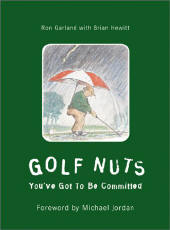Golf Nuts: You’ve Got to Be Committed
I didn’t think it was possible.
The golf fanatics described in this book make me look deeply sane by comparison.
Ron Garland is the founder of the Golf Nuts Society, a social organization with its own website, its own sanctioned tournaments, and its own unique rules for admission and recognition.
In fact, this is the Official Book of the Golf Nuts Society. It should sell very nicely to at least three ready-made audiences.
First, of course, are the Golf Nuts themselves. Most everyone enjoys reading about themselves, and based on the weekly golf column I write, extremely avid golfers are absolutely no exception.
The members of the Society will love this book, as it will confirm their standing within that very special segment of the golfing community.
This book is full of examples of truly out-there golf affliction beyond all reason.
One man plays a round of golf with his future father-in-law on his wedding day, and arrives at the chapel only minutes before the ceremony begins. He then plays 36 holes a day, without his new bride, on the first three days of his honeymoon. The first round on the first day starts at 7:32 a.m.
Not so shockingly, this marriage didn’t last.
Another registered golf nut played golf in Alaska in 25-below temperatures, with a lipped-out putt from 162 yards on the second hole.
Some golf nuts not only know their equipment, they know all about the playing implements of others, too. Garland tells about sitting near the 18th tee of the Phoenix Open with another golf nut, and listening as the man describes in enormous detail the contents of each PGA Tour pro’s bag.
The second most likely purchasers for this book are the golf widows of golf nuts (this is primarily a male sickness, although there are several examples of those of the female persuasion). For these long-suffering spouses, this book should provide a certain amount of comfort, much like the sorts of connections made at an Al-Anon meeting.
The stories will show them that they are in large (if not equally mystified) company, married to golfers who neglect them and their children for the sake of their silly game.
The book recounts several examples of missed birthdays, missed Mother’s Days, missed anniversaries, missed childbirths, and other failures to match up one’s family obligations with one’s devotion to golf.
These segments of the book, it’s safe to say, do not cover Golf Nuts with glory. In fact, many of them seem like arrested adolescents at best, and utterly selfish jerks at worst. On the other hand, in some cases the golf nuts’ focus on the game is a way for them to relieve the stresses of other problems. For these golfers, their families seem to understand that fact.
The third group who will probably buy copies of this book is composed of those who might think they be golf nuts, and/or their families and friends.
Some, for example, may have a tidy little collection of ball markers or logo golf balls from the courses they’ve played. Others might own, say, several dozen golf books or videos. Still others might use two VCRs in one day to capture all the action during an 11-hour broadcast of the Ryder Cup, while they are unavoidably away on a family trip (true story—happened in my own house, actually).
Either these golfers or the folks who know and love them may buy this book, but for somewhat different reasons. These golfers might read this book and be grateful to learn that while they certainly qualify as avid golfers, they’re not completely insane about it.
Others have it far worse.
As for their families and friends, they might think that this book will serve as a cautionary tale, before their particular golfer goes off the deep end.
Either way, it might help.
No matter who buys this book, I would not recommend reading more than a chapter of it at one sitting. It’s hard to read about this much pathology for very long–unless, of course, one is being paid for it.
Review Date: February 9, 2003


